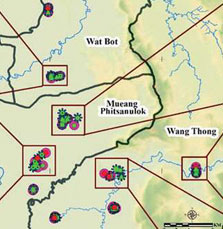Incidence of Entomopathogenic fungi Beauveria bassiana and Metarhizium anisopliae and Associated Rice Pest Insects in Phitsanulok Province, Thailand
Keywords:
Beauveria bassiana, biological control, Metarhizium anisopliae, paddy field, surveyAbstract
This research investigated the incidence of Beauveria bassiana and Metarhizium anisopliae, entomopathogenic fungi (EPF), from infected rice and insect pests in paddy fields at Pitsanulok province, Thailand. The results of the survey of EPFs and insect pests (rice insect pests infected by those two EPFs) revealed that the abundance of some important Lepidoptera pests were 0.01–0.58 insects per site. Pyralid larvae, including the Yellow stem borer (Schoenobis bipunctifer) and Rice leaffolder (Cnapholochrocis medinalis) were mainly found. The dead insects that were infested with B. bassiana or M. anisopliae included the green leafhopper (Nephotettix virescen), and other members of Hemiptera, including plant-leafhoppers, as well as members of Coleoptera, Lepidoptera, and Diptera. Isolation and identification of B. bassiana revealed it had white colonies, filamentous and had definite cell walls. Under the same laboratory condition, M. anisopliae had hyaline to greenish hyphae that formed a sporodochium where conidiogenous cells were born. The basipetally produced chains adhered in distinct cylindrical columns with rounded ends, and were green (phialospores) in color
References
Ali, S., I. Demir, M. H.F. Richard, A. Humber and Z. Demirbag. 2010. Isolation and characterization of entomopathogenic fungi from hazelnut-growing region of Turkey. BioControl 55: 279–297.
Altre, J.A., J.D. Vandenberg and F.A. Cantone. 1999. Pathogenicity of Paecilomyces fumosoroseus isolates to diamondback moth, Plutella xylostella: correlation with spore size, germination speed, and attachment to cuticle. Journal of Invertebrate Pathology 73: 332 - 338.
Barrion, A.T. and J.A. Litsinger. 2010. Taxonomy of rice insect pests and their arthropod parasites and predators. New Delhi India. 700 p.
DeBach, P. and D. Rosen. 1991. Biological Control by Natural Enemies. Cambridge University Press. New York. 440 p.
DeFaria, M.R. and S.P. Wraight. 2007. Mycoinsecticides and Mycoacaricides: A comprehensive list with worldwide coverage and international classification of formulation types. Biological Control, 43(3): 237–256.
Feng, M., T.J. Poprawski and G. Khachatourians. 1994. Production, formulation and application of the entomopathogenic fungus Beauveria bassiana. Biocontrol Science and Technology 4: 3-34.
Ferron, P. 1981. Pest control by the fungi Beauveria and Metarhizium, pp. 465-482. In Burges, H.D. (Ed.), Microbial Control of Pests and Plant Diseases 1970 - 1980. Academic Press, New York.
Goettel, M.S., and G.D. Inglis. 1997. Fungi: Hyphomycetes, pp.213-249. In Lacey, L. (Ed.), Manual of techniques in Insect Pathology. Academic Press, San Diego, CA.
Goral, V.M. 1978. Effect of cultivation conditions on the entomopathogenic properties of muscardine fungi. In “Proceedings of the First Joint US/USSR Conference on the Production, Selection and Standardization of Entomopathogenic Fungi of the US/ USSR Joint Working Group on the Production of Substances by Microbiological Means”. Conf. Riga, Latvia SSR, May 20 - 21, 1978. pp. 217-228.






